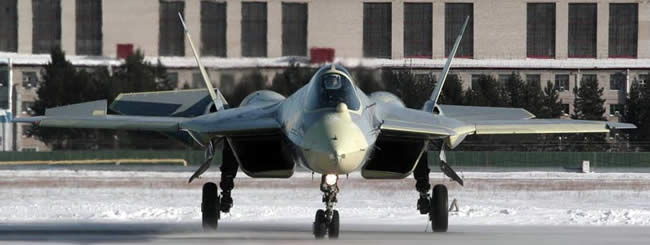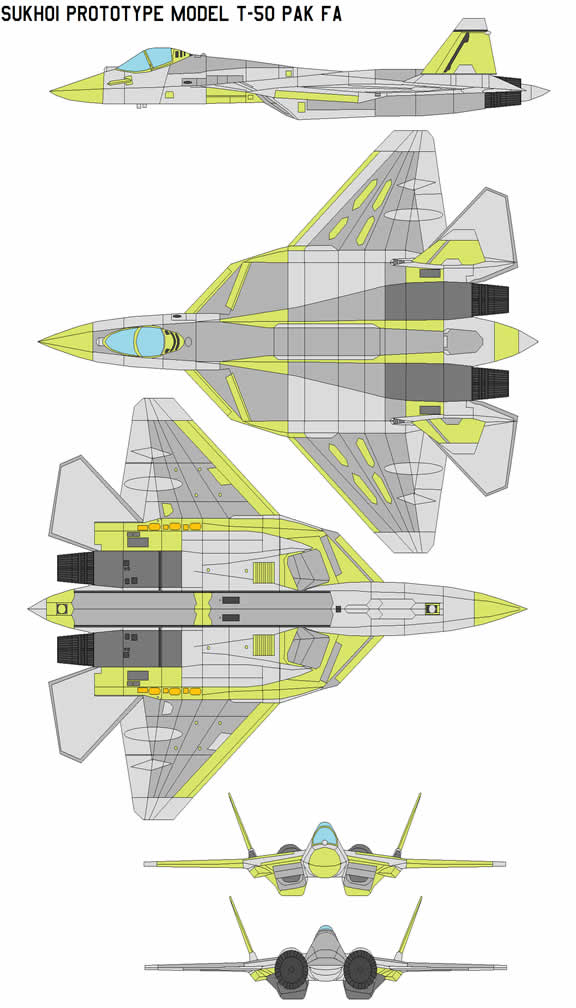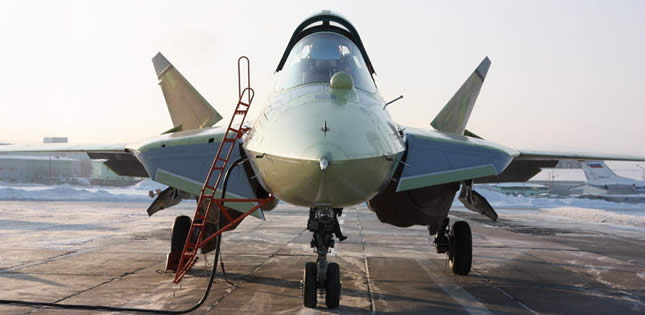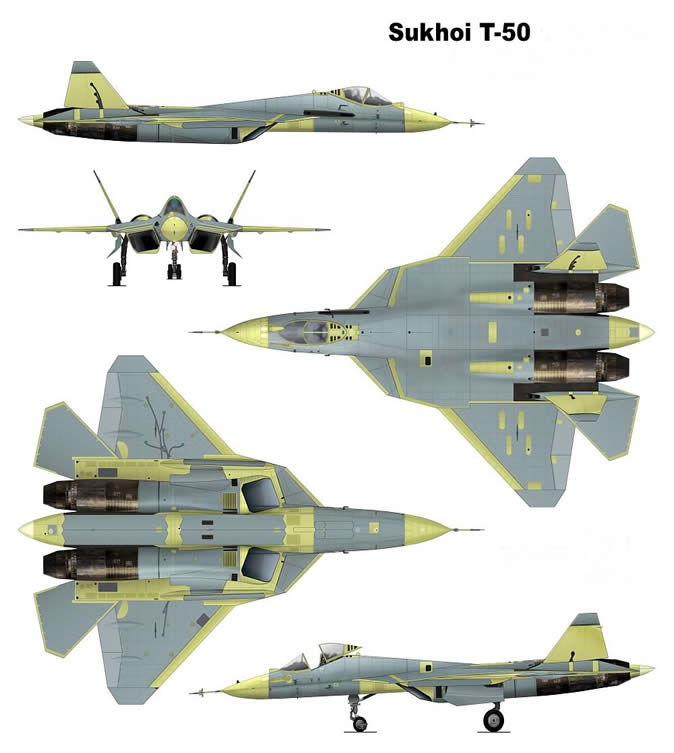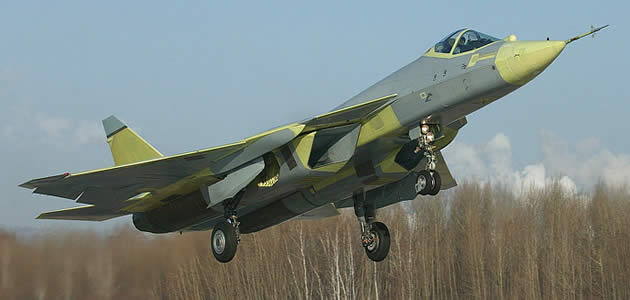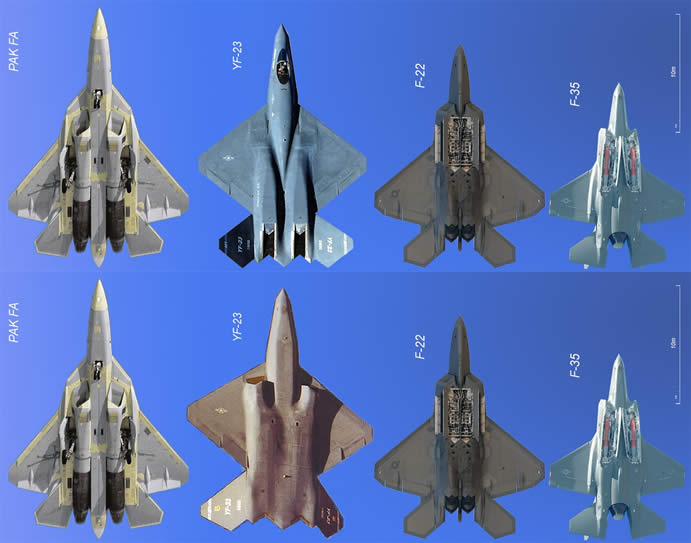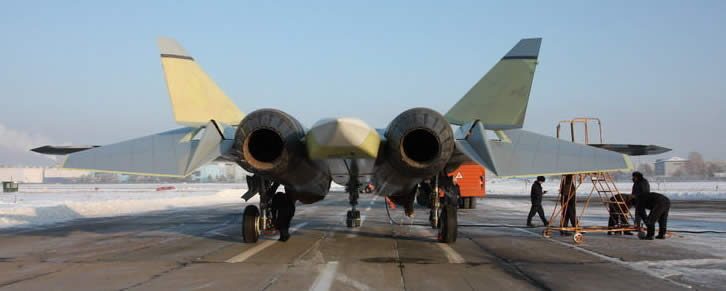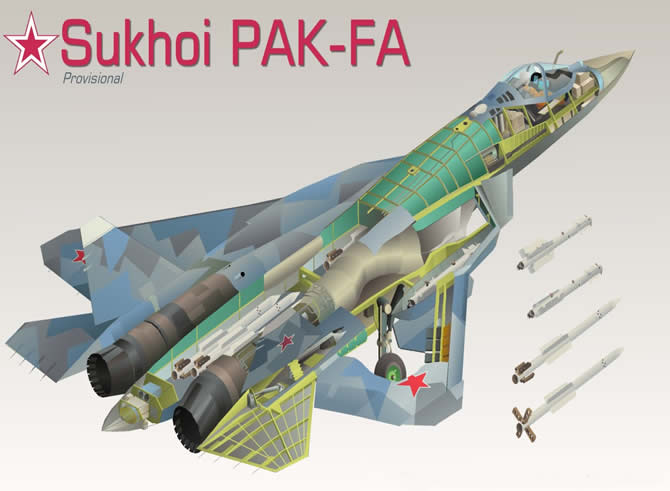RUSSIAN SUKHOI T-50 SU-50 PAK FA STEALTH FIGHTER
MILITARY JET AIRCRAFT PICTURES, REFERENCE AND FACTS
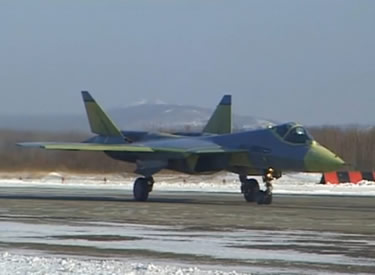 |
 |
SUKHOI T-50 PAK FA STEALTH FIGHTER MILITARY JETThe Sukhoi PAK FA "Future Frontline Aircraft System" is a fifth-generation jet fighter being developed by for the Russian Air Force. The current prototype is Sukhoi's T-50. The PAK FA when fully developed is intended to replace the MiG-29 Fulcrum and Su-27 Flanker in the Russian inventory and serve as the basis of the Sukhoi / HAL FGFA project being developed with India. A fifth generation jet fighter, it is designed to directly compete with Lockheed Martin's F-22 Raptor and F-35 Lightning II. The T-50 performed its first flight January 29, 2010. Its second flight was on February 6 and its third on February 12. As of June 17'th, it has made 16 flights in total.
Sukhoi director Mikhail Pogosyan has projected a market for 1,000 aircraft over the next four decades, which will be produced in a joint venture with India, two hundred each for Russia and India and six hundred for other countries. He has also said that the Indian contribution would be in the form of joint work under the current agreement rather than as a joint venture. The Indian Air Force will "acquire 50 single-seater fighters of the Russian version" before the two seat FGFA is developed. The Russian Defense Ministry will purchase the first "six to ten" aircraft after 2012 and the rest of the "more than 50" after 2016.
In the late 1980s, the Soviet Union outlined a need for a next-generation aircraft to replace its MiG-29 and Su-27 in frontline service. Two projects were proposed to meet this need, the Sukhoi Su-47 and the Mikoyan Project 1.44. In 2002, Sukhoi was chosen to lead the design for the new combat aircraft, and in the summer of 2009 the design was approved. The PAK FA will incorporate technology from both the Su-47 and the MiG 1.44.
The Tekhnokompleks Scientific and Production Center, Ramenskoye Instrument Building Design Bureau, the Tikhomirov Scientific Research Institute of Instrument Design, the Ural Optical and Mechanical Plant (Yekaterinburg), the Polet firm (Nizhniy Novgorod) and the Central Scientific Research Radio Engineering Institute (Moscow) were pronounced winners in the competition held in the beginning of 2003 for the development of the avionics suite for the fifth-generation airplane. NPO Saturn has been determined the lead executor for work on the engines for this airplane.
The Novosibirsk Chkalov Aviation Production Association (NAPO Chkalov) has begun construction of the fifth-generation multirole fighter. This work is being performed at Komsomol'sk-on-Amur together with Komsomolsk-on-Amur Aircraft Production Association; the enterprise's general director, Fedor Zhdanov reported during a visit to NAPO by Novosibirsk Oblast's governor Viktor Tolokonskiy on 6 March 2007. "Final assembly will take place at Komsomol'sk-on-Amur, and we will be carrying out assembly of the fore body of this airplane," Zhdanov specified.
On 8 August 2007, Russian Air Force Commander Alexander Zelin was quoted by Russian news agencies that the development stage of the PAK FA program is now complete and construction of the first aircraft for flight testing will now begin. Alexander Zelin also said that by 2009 there will be three fifth-generation aircraft ready. "All of them are currently undergoing tests and are more or less ready", he said. On 28 of February 2009 Mikhail Pogosyan announced that the airframe for the aircraft was almost finished and that the first prototype should be ready by August 2009. On 20 August 2009, Sukhoi General Director Mikhail Pogosyan said that the first flight would be by year end. Konstantin Makiyenko, deputy head of the Moscow-based Centre for Analysis of Strategies and Technologies said that "even with delays", the plane would likely make its first flight by January or February, adding that there it would take 5 to 10 years for commercial production.
The maiden flight had been repeatedly postponed since early 2007 as the T-50 encountered unspecified technical problems. Air Force chief Alexander Zelin admitted as recently as August 2009 that problems with the engine and in technical research remained unsolved. The Weekly Standard reported that Russian sources had indicated that the T-50 prototype would fly in 2010 or early 2011 with current technology radar and avionics as the advanced systems for the completed PAK FA will require help from a foreign partner.
On December 8, 2009, Deputy Prime Minister Sergei Ivanov announced that the first trials with the fifth-generation aircraft would begin in 2010. The testing, however, has commenced earlier than stated, with the first successful taxiing test taking place on December 24, 2009. The aircraft's maiden flight took place on 29 January 2010 at KnAAPO's Komsomolsk-on-Amur Dzemgi Airport; the aircraft was piloted by Sergey Bogdan (Сергей Богдан) and the flight lasted for 47 minutes.
A second airframe is planned to join the flight testing later in fourth quarter of 2010. These first two aircraft will lack radar and weapon control systems, while the third and fourth aircraft, to be added in 2011, will be fully functional test aircraft. Navalized Sukhoi T-50 PAK FAs will be deployed on the Russian aircraft carrier Admiral Kuznetsov and future Russian aircraft carriers.
Although most of information about the PAK FA is classified, it is believed from interviews with people in the Russian Air Force and Defense Ministry that it will be stealthy, have the ability to supercruise, be outfitted with the next generation of air-to-air, air-to-surface, and air-to-ship missiles, incorporate a fix-mounted AESA radar with a 1,500-element array and have an "artificial intellect".
Sukhoi says that the new radar will reduce pilot load and that the aircraft will have a new data link to share information between aircraft. Composites are used extensively on the T-50 and comprise 25% of its weight and almost 70% of the outer surface. It is estimated that titanium alloy content of the fuselage is 75%. Further reductions in structural weight, drag and radar signature are achieved by the use of three-dimensional thrust vectoring engines. Sukhoi's concern for minimizing RCS (and drag) is also shown by the provision of two tandem main weapons bays in the centre fuselage, between the engine nacelles. Each is estimated to be between 4.9-5.1m long. The main bays are augmented by bulged, triangular-section bays at the wing root. The Moskovsky Komsomolets reported that the T-50 has been designed to be more maneuverable than the F-22 Raptor at the cost of making it less stealthy than the F-22.
Avionics The PAK-FA will have two X-Band AESA radars located on the front and back of the aircraft. These will be accompanied by L-Band radars which are thought to be located on the wing LERX sides, or on the wing leading edges. L-Band radars are proven to have increased effectiveness against VLO targets which are optimized only against X-Band frequencies, despite being less accurate. The PAK-FA will feature an IRST optical/IR search and tracking system. Sukhoi recently demonstrated cockpit mock-ups, which may relate to both Su-35 or PAK-FA, suggest two very large MFDs and a very wide HUD. Hindustan Aeronautics Limited will provide the navigation system and the mission computer. Engines The PAK FA was expected to use a pair of Saturn 117S engines on its first flights. The 117S (AL-41F1A) is a major upgrade of the AL-31F based on the AL-41F intended to power the Su-35BM, producing 142 kN (32,000 lb) of thrust in afterburner and 86.3 kN (19,400 lb) dry. In fact, PAK FA already used a completely new engine in its first flight, as stated by NPO Saturn. The engine is not based on the Saturn 117S. The engine generates a larger thrust and has a complex automation system, to facilitate flight modes such as maneuverability. Exact specifications of the new engine are still secret. Each engine can independently vector its thrust upwards, downward or side to side. Vectoring one engine up with the other one down can produce a twisting force. Therefore the PAK FA will be the first fifth generation fighter with full 3-D thrust vectoring along all three aircraft axes: pitch, yaw and roll. Testing The first flight video shows that PAK-FA has no conventional rudders, its vertical tails are fully movable. This special tail fin design is mechanically similar to V-tails used by the Northrop YF-23 in 1990s, but is supplemented by dedicated horizontal stabilators (as on the F-22). The T-50 has wing leading-edge devices above the jet engine intakes that have been called a challenge for signature control. General characteristics * Crew: 1 Performance * Maximum speed: 2,600 km/h (Mach 2.45) (1,615 mph) ; at 17,000 m (45,000 ft) altitude Armament * Guns: None on prototype. Apparent provision for a cannon (most likely GSh-301) Avionics N050 BRLS AFAR / AESA built by Tikhomirov NIIP and based on Tikhomirov NIIP N035 Irbis-E . It will be the second aircraft based AESA Radar to be built by Russia, the first being the Phazotron NIIR ZHUK-A Radar in the MIG-35. Designed armament Two Izdeliye 810 Extended beyond visual range missiles per weapons bay. Multiple Izdeliye 180 / K77M beyond visual range missiles. K74 and K30 within visual range missiles can also be carried.
|
© AviationExplorer.com - The Website For Aviation Enthusiasts |





